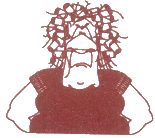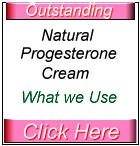History, Health Risks, Where Progestin Fits In, Hormones Mean Big Money,
Natural Progesterone - The Safe Alternative, References
See our Womens Health Page for much much more
Estrogen Replacement Therapy (ERT) and Hormone Replacement Therapy (HRT) have traditionally been used by menopausal women to combat the adverse symptoms associated with the process. Most women experience menopause sometime around age 50.
According to Sherrill Sellman, author of Hormone Heresy, investigative hormone replacement dates back to the 1930s with the research of Dr. Serge Voronoff. His research involved implanting fresh monkey's testicles into mens scrotums, with limited effectiveness. This led to the grafting of monkey ovaries in women, with dire consequences.
Sellman notes that hormone replacement really didn't get rolling until the 1960s. In 1966 a New York gynecologist, Dr. Robert Wilson, wrote a best-seller called Feminine Forever, extolling the virtues of estrogen replacement. His book sold over 100,000 copies in the first year.
According to Wilson, estrogen replacement was a kind of long-sought-after youth pill that would save poor, fading women from the horrors of age. He popularized the erroneous belief that menopause is an estrogen deficiency disease.
According to Dr. John Lee, in his book, What Your Doctor May Not Tell You about Menopause, Ayerst, the first maker of a conjugated estrogen (Premarin) encouraged Wilson in his publicity for estrogen replacement therapy. The Wilson Foundation was set up for the sole purpose of promoting the use of estrogen drugs. The pharmaceutical industry generously contributed over US$1.3 million to this effort.
Estrogen replacement therapy took off. However, there really was not any solid research behind the idea.. According to Dr. Lee, the approval of estrogen as a prescription drug was based on a "dubious study with a relatively small number of women in Puerto Rico who took birth control pills." In this study. 20 percent of the women complained of side effects, but, according to Lee, they were dismissed as neurotic.
Estrogen replacement therapy moved on.
In 1975, however, bad news struck. The New England Journal of Medicine examined the rates of endometrial cancer for estrogen consumers and concluded that the risk was seven-and-a-half times greater for estrogen users. Women who had used estrogen for seven years or longer were 14 times more likely to develop cancer. This caused a sudden drop in estrogen sales.
Ray Peat, Ph.D., a research biologist in Oregon, notes in his newsletter that estrogen can cause breast cancer, heart disease, strokes, accelerated aging, and many other serious problems, and that there is no valid scientific evidence of its safety in any amounts.
The solution to the drop in sales of estrogen was to add progestin - a synthetic progesterone - to the treatment regimen. This would balance the estrogen and lower the risk of endometrial cancer. The promotion of this new treatment - dubbed Hormone Replacement Therapy (HRT) -continued. The hormone replacement juggernaut was still on.
Recent findings show that HRT may have brought on more problems than it eliminated. A 1995 study in the New England Journal of Medicine, involving 121,700 women, warned that women who used HRT to offset the symptoms of menopause also increased their chance of developing breast cancer by 30 to 40 percent by taking the hormone for more than five years. In women aged between 60 and 64, the risk of breast cancer rose to 70 percent after five years of HRT. Finally, the study concluded that women using HRT were 45 percent more likely to die from breast cancer than those who chose not to use HRT or who used it for less than five years.
To compound this, although HRT research is based on the best available research, the research is not adequate. According to an article in the June 26, 1995 (Vol.145, No.26) issue of Time Magazine, "most of the controlled studies on estrogen therapy have been short-term and can shed no light on long-term risks."
Part of the problem lies in the type of hormone that is added to estrogen in HRT. Although the first progesterones were derived from diosgenin, pharmaceutical companies saw no advantage in this, and instead used the diosgenin to create synthetic versions of progesterone known as progestins. Progestins were created because, as Dr. Lee states in his book, What Your Doctor May Not Tell You about Menopause, "Man-made hormones not found in nature are far more profitable for the pharmaceutical companies than natural hormones because unlike natural substances, they can be patented. Thus pharmaceutical funding for progesterone research early on veered in the direction of creating new and patentable synthetic progesterone analogs made from the yam-derived natural progesterone."(1)
The advantage of these progestins were 1) ease of delivery system; 2) consistent potency; 3) longer duration of action; and 4) they were patentable.
Dr. Peat, in his widely accepted newsletter, notes that "Physicians often confuse the synthetic progestins with natural progesterone. The brand of medroxyprogesterone acetate called Provera is often mistakenly called progesterone."
Dr. Lee quotes an abbreviated list of medroxyprogesterone acetate side effects from the Physicians Desk Reference (1995). Following is a yet more abbreviated list:

With all of this known, why is HRT still suggested?
Responsible physicians realize that there are both risks and benefits to HRT and inform their patients of this. It is, after all, the woman's decision to weigh the benefits and risks of HRT. However, the field seems to be slanted toward using HRT. There is too much money involved.
Woman's health is big business. There are some 30 million menopausal women in North America and some 20 million more will soon be menopausal. With these millions of potential customers, no one wants to blow the whistle on the golden egg. Premarin, a form of HRT made from pregnant mare's urine by Wyeth-Ayerst Company, is a top selling product in the U.S. Industry projections for hormone replacement sales by the year 2000 are up to one billion dollars a year. Estimates put Premarin's 1992 sales worldwide at $700 million, and in 1994, Premarin ranked as the number eight pharmaceutical product in dollar volume, up 12 percent from 1993.
According to researchers at the Food and Drug Administration, estrogen prescriptions in the U.S. more than doubled between 1982 and 1992. About 10 million women use a form of HRT.
Added to the financial incentive, is the fact that the information physicians receive comes from the pharmaceutical companies themselves. According to Dr. Peat. "hundreds of millions of dollars of annual profits from estrogen products allow the companies to subsidize medical conferences, medical research, medical journals and medical schools. The information physicians receive is heavily biased in favor of estrogen treatment by that funding."
Dr. Lee, in his book Natural Progesterone: The Multiple Roles of a Remarkable Hormone, comments on what he calls the medical-industrial complex. "The medical-industrial complex refers to the close-knit association of organized medicine with pharmaceutical manufacturers and governmental medical regulatory agencies. The connections between these groups is, of course, a web of money, power, and prestige.
"The potential market for progestins is vast - contraceptive pills, irregular menses, osteoporosis, prevention of endometrial cancer - literally every woman through every age from puberty on is a target for sale. Do you think the prevailing powers wish to see this lucrative market . . . not controlled by the pharmaceutical industry?"(2)
With this type of pressure for HRT, you can see how other ideas may get lost, that the whole story is not always given, and that HRT continues to be the traditional answer for menopausal women.

Natural progesterone is not progestin, although many physicians believe they are the same thing. The difference between the two is two-fold:
A progestin can start with the same plant extract, but is converted to a molecular structure that is not of the same molecular structure produced by the body.
Dr. John Lee has used natural progesterone for 15 years in his clinical practice and currently travels worldwide speaking on natural progesterone. Dr. Lee has published two books on natural progesterone -What Your Doctor May Not Tell You About Menopause and Natural Progesterone: The Multiple Roles of a Remarkable Hormone - and a number of articles on natural progesterone in peer-reviewed journals.
Dr. Lee notes, "In the fifteen years since (I have started using natural progesterone in my practice), I have seen the consistent benefits and the safety of natural progesterone therapy." (2)
Dr. Lee also comments on a study done by Hargrove et al. "When Hargrove et al., compared oral progesterone with medroxyprogesterone acetate (Provera) in combined hormonal therapy with estrogen for menopausal women, they found superior symptomatic improvement, an improved lipid profile, amenorrhea without endometrial proliferation or hyperplasia, and no side effects in the group given progesterone." (2)
The Hargrove study Dr. Lee quotes also states that of the ten women given estrodiol/progesterone (natural progesterone) none experienced side effects and wished to continue the therapy, while two of the ten women using conjugated estrogen and medroxyprogesterone acetate requested discontinuation due to side effects. The study itself notes that, "Most significantly, the adverse effects of synthetic progestins on lipoproteins and cholesterol were eliminated by using natural progesterone." (3)
Dr. Lee concludes his technical book, Natural Progesterone: The Multiple Roles of a Remarkable Hormone, by saying, "because of its many benefits, its great safety, and particularly its ability to oppose the carcinogenic effects of estrogens, natural progesterone deserves far more attention and application than generally given in the prevention and care of Womens Health today. "(2)
Studies support Dr. Lee's assertions on the efficacy and safety of natural progesterone- An article in the May, 1996 issue of Pharmacotherapy concerns the administration of a micronized form of natural progesterone. The authors of the study comment that "Most of the problems that accompany progestins could be avoided or profoundly reduced if natural progesterone could be administered …." They go on to say, "This oral product has been effective and safe in women with absent ovaries, premenstrual syndrome, and premature labor, and for postmenopausal hormone-replacement therapy." (4)

An article in the March, 1985 issue of the American Journal of Obstetrics and Gynecology discussed how progestogens (progestins) and natural progesterone affect high-density lipoprotein cholesterol in estrogen replacement therapy. It notes that "natural progesterone had no apparent influence on high-density lipoprotein cholesterol or its subtractions and may develop into an attractive alternative to synthetic progestogens."(5)
There has also been some confusion over the term "natural progesterone" and its sources- Authorities in the field, such as Drs. Lee and Peat and others, use the term "natural to mean "progesterone that has the same molecular structure as that found in the body." They do not mean that the natural plant source is the active ingredient. Others misinterpret "natural" to mean "the natural element is active directly from the source." In other words, that the natural plant source is the active ingredient.
There have also been questions about source. Some people believe a substance can be referred to by its source ingredient even if further processing takes place. For instance, corn oil is processed and refined, yet we consider corn oil a natural substance. Others, however, feel that any changes from the original state make a substance "unnatural." Under this definition. corn oil would be considered synthetic.
Copyright © 2003 Loren & Kathy Schiele -- All Rights Reserved
.